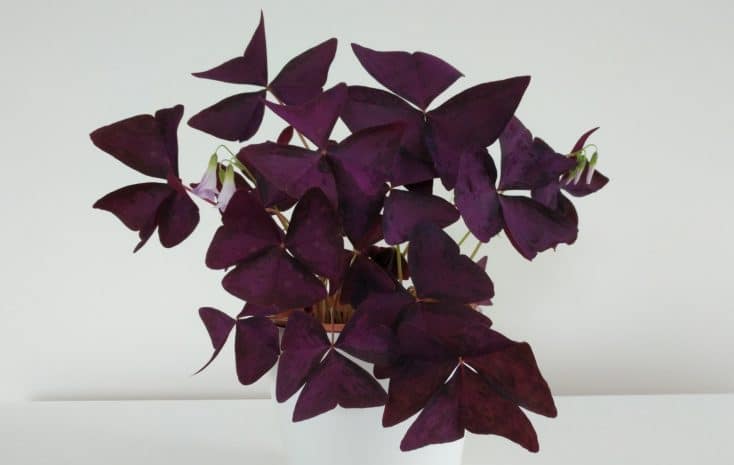With its stunning and eye-catching purple foliage, Oxalis triangularis or Purple Shamrock is sure to be the star of the show wherever placed indoors. Provided the proper indoor growing conditions, it will provide you with robust growth and color throughout the seasons. Below is a quick summary of its care.
Oxalis Triangularis care summary: To keep your Purple Shamrock plant healthy, grow in rich, well-drained potting mix and water when the top inch of soil becomes dry. Maintain moderate humidity, fertilize every two to three weeks, situate in bright light and keep indoor temperature between 60°F to 75°F.
Continue reading because we have taken all the mystery out of growing and caring for Purple Shamrocks indoors and having healthy plants showcasing their purple glory.
How To Care For Oxalis Triangularis
Purple Shamrock owns its name triangularis due to the triangle shaped leaves in a deep purple, with a lighter purplish-rose feature in their center. Although the robustly colored leaves are the stars of the show, the plant also produces small, trumpet-shaped flowers in spring in colors of pink or white. The blooms last for several weeks. Another feature of the leaves is they open during the daytime hours and close in the evening.
Those living in mild climates can grow Oxalis Triangularis year-round outdoors as a ground cover. If your conditions are too cold in winter, you can dig the bulbs and store until spring’s warm temperatures arrive again. Plants average around 12 inches tall at maturity.
Purple Shamrock is sure to be an indoor feature and grab the eye’s attention whether grown alone in a container or part of a mixed container garden. It is quite attractive when mixed with plants with silver or white foliage like Dusty Miller or Spider Plant.
In fact, the Royal Horticultural Society has awarded Purple Shamrock the Award of Garden Merit. When properly cared for, Purple Shamrock will grace your indoor space with their outstanding color for years to come.
Why Is Oxalis Triangularis Called False Shamrock?
Another common name for Oxalis triangularis is False Shamrock, because many times it’s commercially marketed as a true shamrock or clover (Trifolium spp.), native to Ireland.
This is due to Purple Shamrock’s three petals and similar looks to that of clover. Actually, it is a member of the wood sorrel family and is a Brazilian native.
Some of the major differences between the Purple Shamrock and true shamrocks is it is better adapted to indoor growing conditions, as the conditions aren’t bright enough for clovers to grow properly. In addition, true shamrocks have a fibrous root system, whereas Purple Shamrock and most species of Oxalis have a bulb-like or tuberous root system.
Another major difference is true shamrocks perform as annuals and the Purple Shamrock is a perennial, although it usually goes through a period of dormancy about once per year.
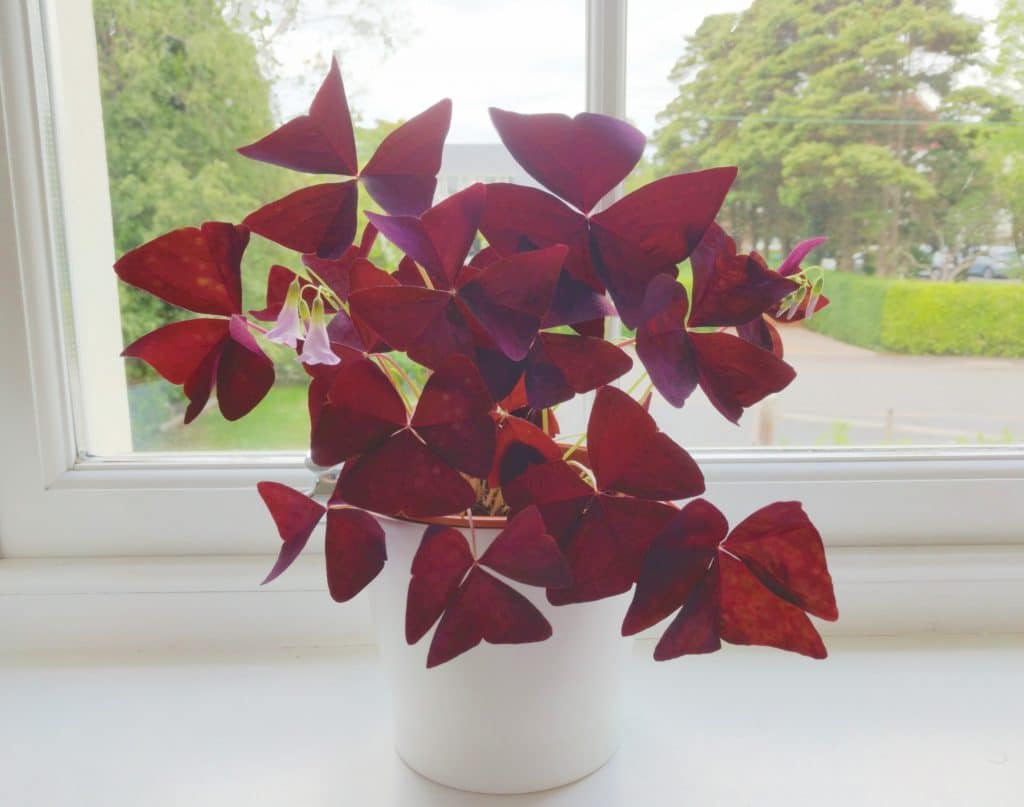
Soil Conditions For Oxalis Triangularis
Oxalis triangularis performs well when grown in standard potting mixes that drain well. The bulbs or fibrous roots will rot if planted in soils that are too heavy and retain too much water.
For the best results, use a rich, lightweight potting mix with or without the addition of a slow-release fertilizer. The addition of a fertilizer into the potting mix only means you will not have to worry about fertilizing as frequently as you would with mixes lacking the addition of the fertilizer.
Many types of potting soil are too heavy and don’t drain properly, which can lead to problems with rot. However, if that is what you have on hand you can lighten the mixture before planting your Purple Shamrock. Some soil mixture suggestions include:
- Mix one part potting soil with one part potting mix
- Mix one part potting soil with one part peat
- Mix one part potting soil, one part potting mix, one part peat
Whatever mixture you decide to use to grow your Purple Shamrock, the biggest thing to remember is the soil needs to drain properly and not retain too much water. If after you water you notice the water remains on top of the soil, draining slowly, the mixture is too heavy and needs to be lightened.
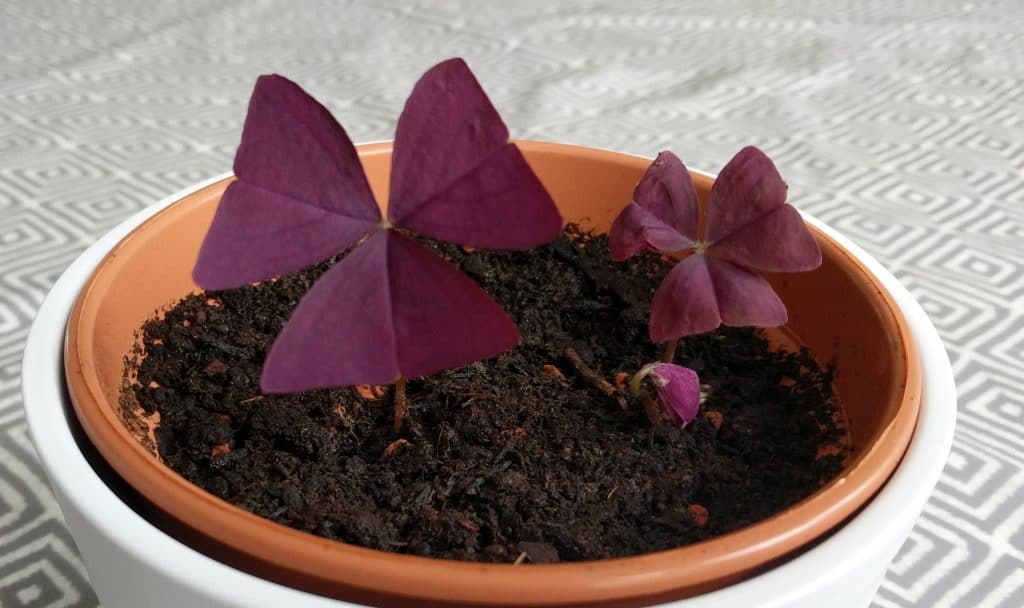
Light Conditions For Oxalis Triangularis Plants
For the best growth, place your Purple Shamrock in an indoor location that receives bright light. If indoor light conditions are too low, the plant’s growth won’t be as robust and it will have a tendency to become leggy.
If you notice this becoming a problem with your Purple Shamrock, just move it to a brighter location. If you desire to give your plant a break from indoor growth, place it in a partially sunny outdoor location and not in full sun. Although it grows best in a bright location indoors, the window reduces some of the sun’s rays and if the location outdoors is too sunny, the leaves can burn.
Indoor Temperature Requirements
The prime indoor temperatures that produce the best growth for Purple Shamrocks are between 60°F to 75°F. When temperatures inside the home become too hot, the foliage will wilt. During winter when conditions inside the home can be warmer due to artificial heating, make sure the plant is not sitting next to a heating vent.
How Often To Water Oxalis Triangularis
Your Purple Shamrock will be more forgiving if you forget to water than if you water too much, which leads to soggy soil conditions and problems with rot. Constantly wet conditions can end up killing your plant, so it’s imperative to water properly.
- During the growing seasons of spring through summer, water when the top inch of soil feels dry.
- During the dormant season of fall and winter, water about every two to three weeks.
It is easy to check if your Purple Shamrock needs water by sticking your finger into the soil. If the top inch or so feels dry to the touch, apply water until it runs from the pot’s bottom drain holes.
During the dormant season, the plant has suspended its growing so it does not require the amount of water it needs while actively growing. When watering, use room temperature water and not water that is too cold.
For more tips on how to assess when your houseplants need water, see this article
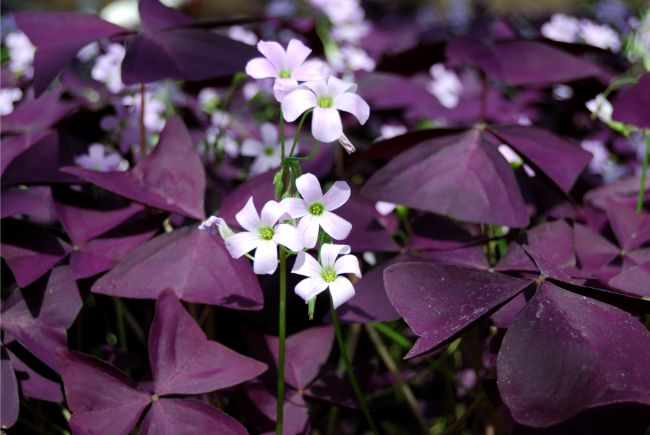
Humidity Requirements
When it comes to proper humidity levels for Purple Shamrock to grow properly, it is not as fussy as many indoor plants. Average humidity levels inside the home are usually adequate.
If the air in your home is particularly dry, here are a few great ways to improve humidity easily.
Oxalis Triangularis Fertilizer Needs
Like watering, you only have to worry about feeding your Purple Shamrock while it is actively growing in spring through summer. Stop feeding in fall and winter when the plant goes into dormancy.
If your potting mix contained a slow-release fertilizer, which continues to feed the Purple Shamrock for up to three months, you won’t have to worry about additional feedings for several months. If you choose to continue feeding using a slow-release blend, scatter the granules over the soil and water in well after applying.
Otherwise, use a water-soluble blend for houseplants applied when you water. To keep your Purple Shamrock looking and growing its best, fertilize every two to three weeks.
Salts can buildup in the soil after continued fertilizer applications, which can result in burned foliage so the soil requires periodic flushing. Take your container to the sink and allow water to run slowly through the soil for about five minutes.
This should remove the unwanted salts from the soil. Once the container drains, move it back to its indoor location. You will probably only have to flush the soil of the unwanted salts about every four to six months.
Pruning Requirements
Other than to pinch off any dead foliage, especially as the plant goes into dormancy, the pruning requirements for Purple Shamrocks are low to none.
Care Through Dormancy
Do not be surprised if you start noticing the leaves on your Purple Shamrock starting to brown and become dry after several months of growing strongly. This is the plant entering a period of dormancy, which normally happens in summer, and is a chance for the corms to rest and recharge before another period of growth.
Dormancy can be a little unpredictable indoors, and sometimes the plant will have several cycles of strong growth, followed by die back during the year. Dormancy can also be triggered by temperatures higher than 80°F (27°C).
When the foliage starts to turn brown and die back, cut back on watering and allow the affected leaves to dry out, before pruning them off. Move your plant to an area that is cool and dark for 2-4 weeks to allow the plant to rest.
After this, move the pot back to a brighter location. Commence normal watering and fertilize the plant to stimulate new growth and your plant should bounce back stronger than ever.
How To Plant Oxalis Triangularis Bulbs
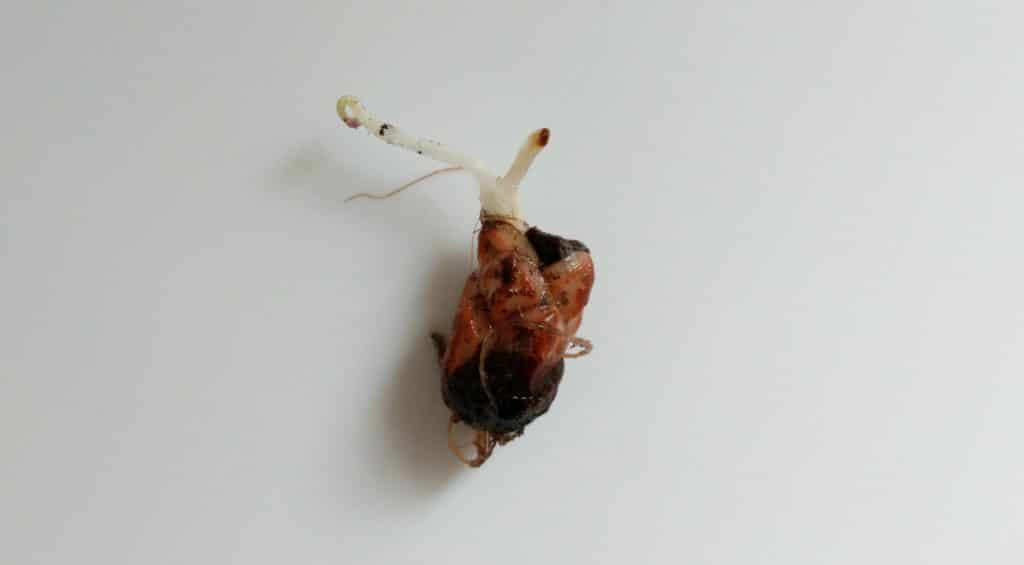
I planted three new pots of Oxalis triangulasis bulbs this spring and the process couldn’t be simpler. It only took a few weeks to go from the bulb pictured above, to the full grown plant you saw at the top of this article.
Major tips to remember when potting your Purple Shamrock are:
- Any type of container works well, just be sure the container has bottom drain holes to prevent problems with rot.
- Use a lightweight potting mix that drains well.
Potting steps:
- Fill a draining container about three-quarters full of a well-drained potting mix. Water the soil to settle it.
- Place the Purple Shamrock bulbs on top of the soil, spacing several inches apart. I planted three bulbs in the pot in the picture below.
- Cover the bulbs with soil so they are planted about 1 to 1.5 inches deep. Water the container’s soil again and until it runs out the bottom of the pot.
- Place the container is a bright indoor location and you should see new growth appear in around 2-3 weeks. I actually saw growth within a week, but my bulbs were already sprouting when I potted them.
- Make sure to keep the potting mix moist while the bulbs are sprouting, then reduce the watering to when the top inch of potting mix is dry. Err on the side of under watering, as root rot is one of the only major problems with this plant.
Repotting Oxalis Triangularis
The plant only requires repotting every few years to add fresh soil or to create new plants from the additional offsets produced. Move up to a container that is one size larger if you aren’t separating the offsets and are just refreshing the soil.
The best time to repot is in winter during the plant’s dormant stage. Just follow the same instructions as for planting new bulbs.
Propagating New Plants
Oxalis triangularis is propagated by separating the offsets to create additional plants. This is best done while the shamrock is in its dormant stage. Remove the Purple Shamrock from its container and gently pull the bulbs apart. Once separated, you can plant the bulbs in new containers.
Before you consider repotting or separating offsets, make sure to allow the foliage to die naturally and don’t trim it off too soon and while it still has color. The bulbs are still gathering nutrients from the foliage and cutting it off too soon can lead to weaker bulbs that don’t perform as well when replanted.
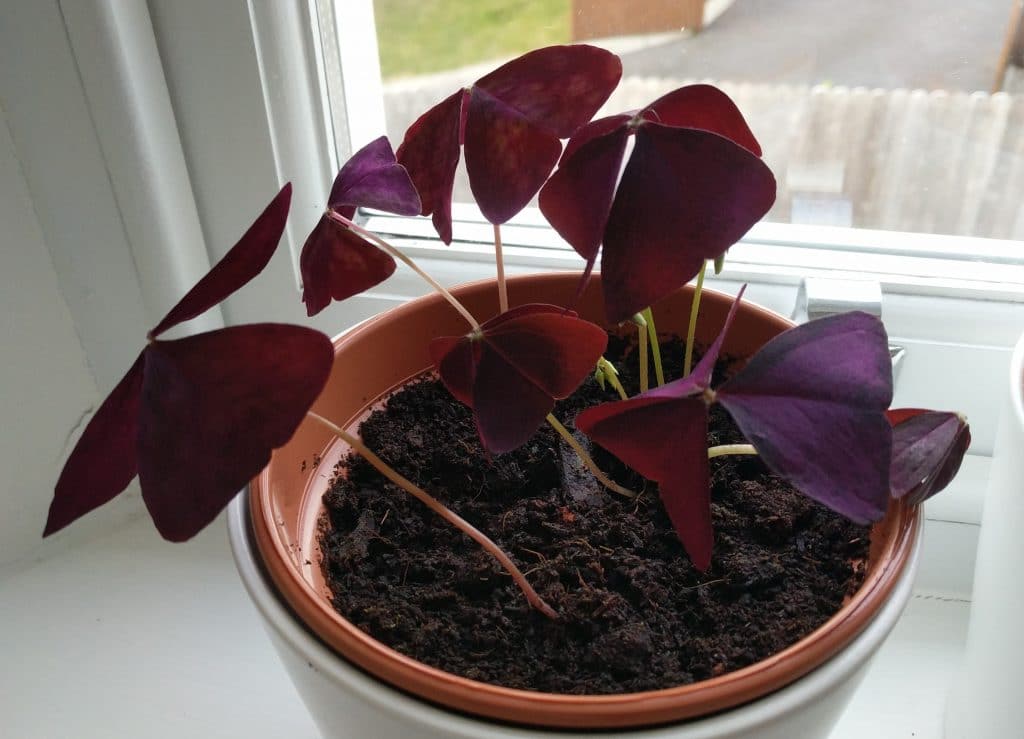
I’ve also recorded a video about my experience growing Oxalis triangularis and discussing the care needs of this fantastic plant. Check it out below.
Disease Problems
For the most part, Purple Shamrock plants are relatively free of serious disease problems. However, overwatering or growing it in too soggy conditions can cause problems with rot.
When rot is the problem, the underground bulbs turn black and mushy and the entire plant eventually collapses and dies. When this happens, it’s best to just discard the plant and start with a fresh one, watering when the top inch of soil becomes dry and being sure to grow the shamrock in soil that drains well.
The other two problems that can affect Purple Shamrock plants are the fungal diseases powdery mildew and rust. These problems usually occur when temperatures are cool, there is too much humidity and the plant isn’t getting adequate light. Both problems are easy to identify.
- Powdery Mildew: Powdery mildew shows up on the plant as powdery white patches that affect all portions of the shamrock including the blooms. In severe cases, the powdery substance can coat the entire plant.
- Rust: Rust shows up as small, light yellow flecks on the foliage, as well as a white powdery substance covering all portions of the plant.
Most of the time these problems aren’t severe and rarely require treatment, other than moving the plant to a bit warmer and brighter location, if possible and decreasing the amount of humidity. However, if the problem is growing you can spray the Purple Shamrock with a fungicide, repeating as suggested on the product label.
Pest Problems
When it comes to possible pests on your indoor Purple Shamrock, the two biggest threats are spider mites and mealybugs. In severe cases of infestation and if left untreated, both pests can kill your Purple Shamrock plant, as well as spread to your other houseplants, so quick treatment is advised. Identifying both pests is easy.
- Mealybugs: Mealybugs show up on the Purple Shamrock as masses of a white cottony substance, which are actually groups of the pests. They suck out the plant’s juices and can weaken or kill it.
- Spider Mites: Spider mites are tiny, sap-sucking insects that spin a fine webbing over the Purple Shamrock. Like mealybugs, an untreated infestation can weaken or kill the plant.
Treat both pests by spraying both sides of the foliage and all other areas of the Purple Shamrock with an insecticidal soap or neem. Repeat the treatment as directed on the product’s label.
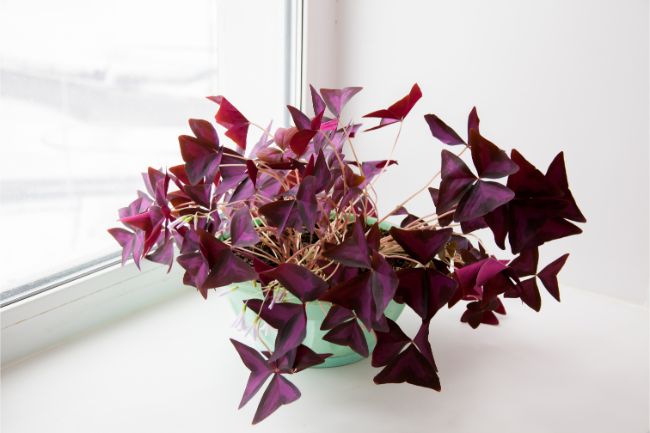
Why Are My Purple Shamrock’s Leaves Turning Yellow?
If your Purple Shamrock’s foliage starts yellowing it usually means you are giving the plant too much water. This can be caused by watering too often, growing in soil that doesn’t drain well or you’ve planted in a container that doesn’t have bottom drain holes.
If the soil and container are not the problem, then reduce the frequency of your water applications. During the growing seasons of spring through summer, water when the top inch of soil becomes dry, which will probably be once each week. However, when the Purple Shamrock is dormant in fall and winter cut back watering to about once every two to three weeks.
If you are watering correctly, check the pot for a drain hole and if needed, repot into a proper draining container and use a rich soil blend that drains well.
What Causes White Spots On My Purple Shamrock’s Leaves?
If your Purple Shamrock develops white spots on its leaves, this is generally a sign of two fungal problems powdery mildew or rust. If rust is the problem, there is the addition of tiny light yellow flecks on the leaves too.
Both problems are caused by conditions that are too dark, too cool and there’s too much humidity. You can move the plant to brighter and warmer conditions, as well as cut down on the humidity. In addition, you can spray the entire plant with a fungicide to control the problem.
How Can I Propagate New Oxalis Triangularis Plants?
While the Purple Shamrock is dormant in fall and winter, gently remove it from its container and carefully separate the bulbs. Plant the bulbs in a new container, making sure it has bottom drainage and into a well-drained soil. Space multiple bulbs several inches apart and plant about 1.5 inches deep in the soil.
Is Oxalis Triangularis Toxic To Cats?
The leaves of Purple Shamrock have a bitter taste, which usually prevents cats and dogs from having more than a small taste, however, they contain oxalic acid, which is toxic when large quantities are consumed.
Do Purple Shamrock Leaves Close At Night?
Like the majority of Oxalis types, the leaves of Purple Shamrock close at night and reopen during the daytime hours.

